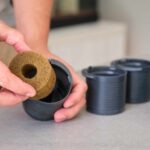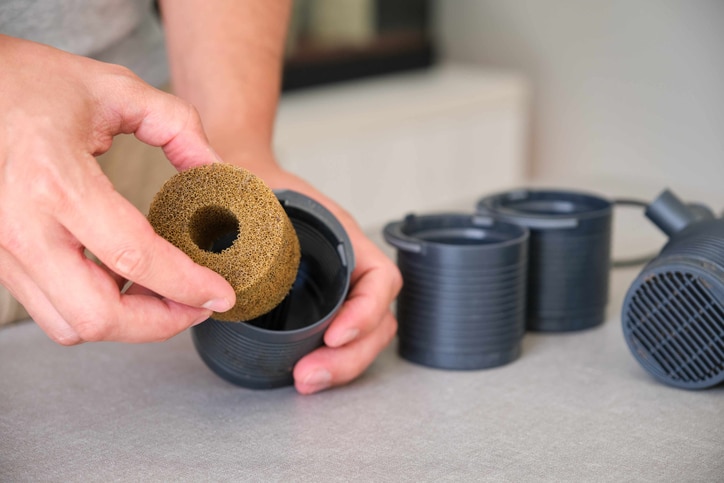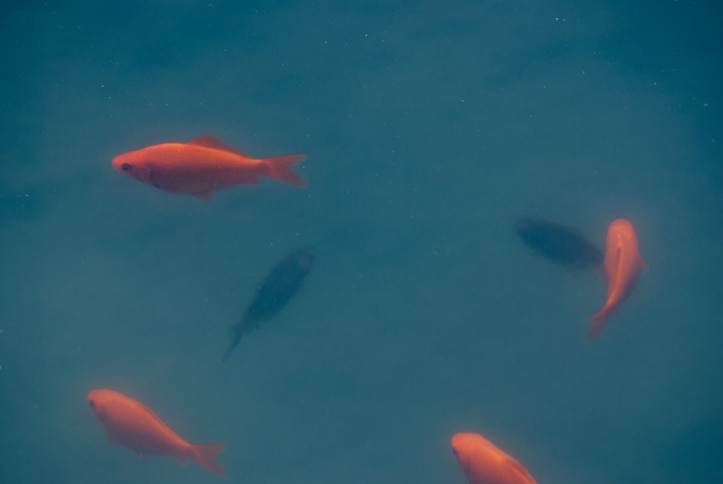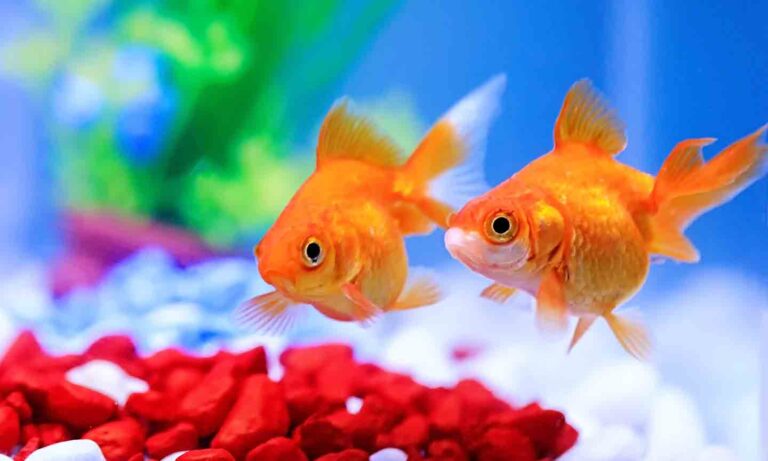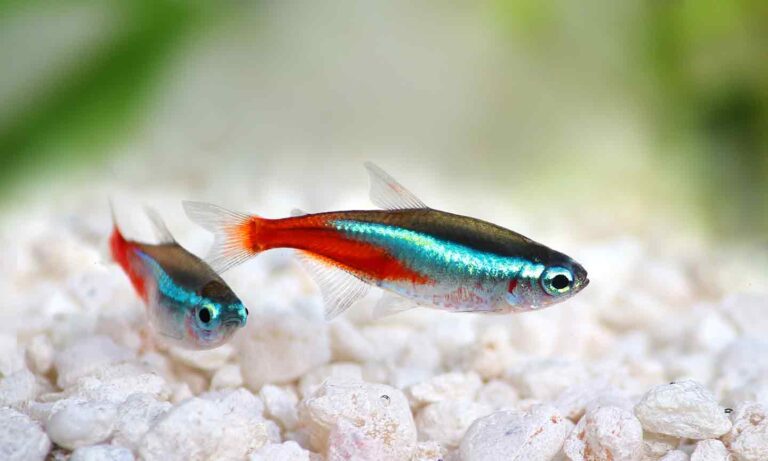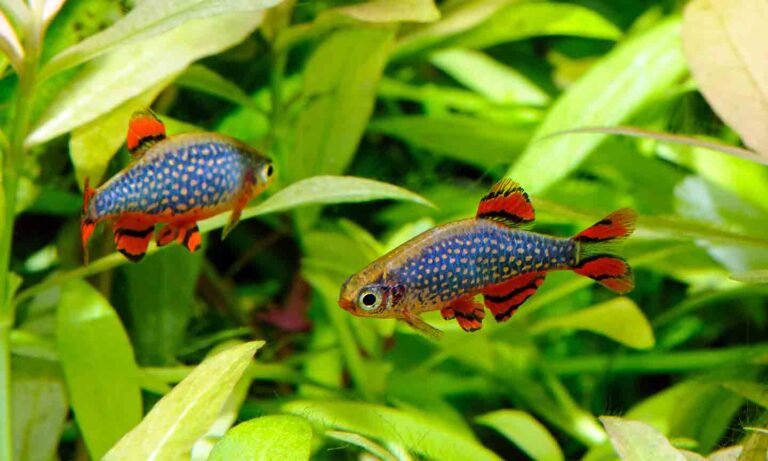Cloudy Water in a Freshwater Fish Tank: Causes and How To Get Rid of It
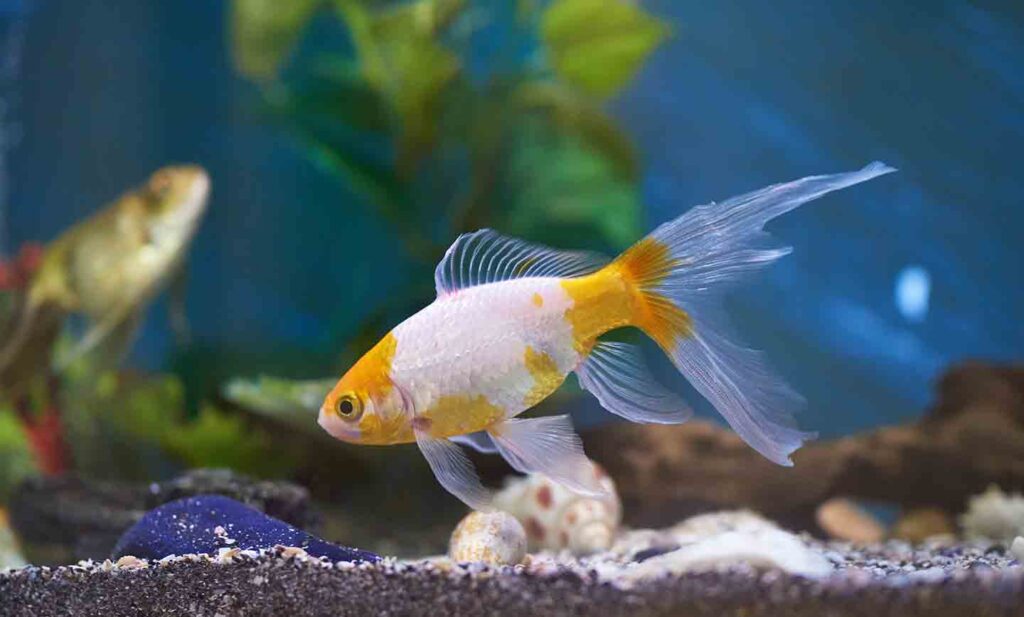
Photo by dimarik/Getty
So, you finally set up that fish tank you’ve been imagining. You add your first batch of fish to the aquarium and a couple days later it looks like you poured a glass of milk into the tank. What’s up with the cloudy water in your freshwater fish tank?
Based on the color of the water and the circumstances under which the cloudiness appears, you can determine the cause. And while new tanks most frequently suffer from cloudy water, established tanks can have this problem, too. Keep reading to find out why cloudy water happens in freshwater aquariums and what fishkeepers can do to get their clear water back.
Why Is My Fish Tank Water Cloudy?
Reason 1: Insufficiently Washed Gravel
If you have just set up your tank and the water appears cloudy immediately or within a couple of hours, the cause is the substrate, aka the material on the floor of your tank. Unless you have purchased a substrate that specifically says not to rinse it due to the presence of live, cultured bacteria that help cycle your tank (such as Activ-Flora or Eco-Complete by CaribSea), then you need to thoroughly rinse your gravel and/or sand to get rid of silt before adding it to your tank.
If you haven’t rinsed the substrate enough, it will make your tank water extremely cloudy due to all the silt particles still present.
What to Do: You can either drain your tank and re-rinse the substrate more thoroughly (until the water runs clear through it), or just wait it out. The water will clear on its own eventually, because the particulate settles and is removed via filtration, but that could take several days.
Tap water conditioners/clarifiers can also be used to help remove debris that causes cloudiness.
Pro Tip: Certain substrates designed for aquariums with live plants, such as Fluval Bio-Stratum, will make your water cloudy no matter what, because they contain particles that are intended to remain in the tank to support plant health. Whether you rinse it or don’t rinse it, your water will be cloudy for at least 24 hours—but your plants will thank you in the long run.
Reason 2: Bacterial Bloom
When there are more nutrients in the water than the existing beneficial bacteria can consume, the bacterial colony responds by rapidly multiplying. This sudden surge in bacteria density gives the water a milky appearance.
To understand bacterial blooms, you first need to understand bacteria’s role in keeping a healthy aquarium. There are two primary types of bacteria that are essential to fish tanks: Nitrosomonas species and Nitrobacter species. Both are needed to drive the nitrogen cycle, which breaks down waste within the tank, including fish excrement, uneaten or excess food, decaying plant matter and dead aquarium inhabitants.
As waste material decomposes, it generates ammonia, which is highly toxic to fish and can lead to fin damage, irritated gills, swollen eyes, loss of appetite, sluggishness and, ultimately, death. Beneficial bacteria like Nitrosomonas and Nitrobacter convert ammonia into less toxic nitrites. Then, other types of nitrifying bacteria convert the nitrites into nitrates, which are much less toxic.
When beneficial bacteria multiply in your tank, it can give the water a cloudy appearance. Bacterial blooms commonly occur when:
- An aquarium is first set up, or when a large number of fish are suddenly introduced. (This is frequently referred to as “new tank syndrome.”)
- A large portion of the beneficial bacteria is removed or killed, such as through excessive cleaning of the filter media (particularly if it hasn’t been serviced for quite a while) or from the use of certain medications that kill good bacteria.
- The tank is experiencing an increase in waste material, for example due to overfeeding or decaying plants.
What to Do: If your cloudy aquarium water is the result of a bacterial bloom, it will clear up on its own within a week or two after the beneficial bacterial balance is reestablished. To speed things up a bit, keep the aquarium clean by removing debris such as decaying plants and uneaten fish food, vacuum the gravel and perform partial water changes to lower the nitrate levels and remove the excess nutrients driving the bloom.
If overfeeding is the suspected cause, then cut back on the portions. It’s easy to feed our fishes too much because it’s enjoyable to watch them eat and be more active, but overfeeding is an unhealthy practice for many reasons.
You can easily monitor your water parameters by using a water test kit, which will help you keep ahead of any potential issues that could lead to another bloom.
Recommended Products
Reason 3: Algae Bloom
If your water is not only cloudy but also green, you have an algae bloom on your hands. Green water is generally a result of too much light (often direct sunlight) paired with excess fish food and fish waste. If your tank is densely stocked and water changes are not done frequently, the nitrates will be elevated, promoting algae growth. If your tank is near a window and gets lots of natural light, this will also contribute significantly to algae growth, because algae requires light to photosynthesize.
What to Do: There are several courses of action you can take to battle an algae bloom:
- Frequent water changes will help to lower the nutrient load and slow down the algae bloom.
- A UV sterilizer is the quickest, most effective way to get rid of green water. Exposure to UV light irradiates the algal cells at a wavelength that mutates their DNA, rendering them unable to reproduce and effectively ending their lifecycle.
- Some aquarists recommend doing a large water change, turning off the aquarium light, blacking out the tank by wrapping a blanket around it for at least a week, and then doing another large water change afterwards to remove the dead algae. However, this method comes with risks: The lack of light can be problematic for live plants in the tank, and if there’s an ammonia spike from the decomposing dead algae, it will harm your fish.
Recommended Products
Reason 4: Stirred-up Gravel or Sand
Certain types of tropical fish such as loaches, Corydoras catfish and Eartheater cichlids are constantly stirring up the substrate as they sift through it for food. This can send a fair bit of gravel or sand particles up into the water, reducing your water clarity.
What to Do: There are a few strategies for dealing with stirred-up substrate:
- Add extra filtration to your system. Mechanical filtration physically strains debris out of the water. Hang-on-back, canister and sponge filters all perform this function. If you have a customizable filter, you can add a prefilter sponge like this one from Marineland to cover the intake tube, use a coarse sponge pad like Penn-Plax’s Bio-Sponge to catch the larger particles and get a fine poly pad, also from Penn-Plax, or filter floss to trap the smallest particles.
- Improve your water circulation. Increased water circulation helps improve water quality by eliminating “dead spots” in the aquarium (aka places where the water stays more still than others) and keeps loose particles suspended in the water so they can get sucked up by the filter and removed. You can achieve this by adding an air pump with an air stone, a powerhead, or perhaps even another filter depending on the size of your aquarium.
- Use a water conditioner. Water conditioners (clarifiers) can also remove debris that causes cloudiness. They work by bonding to suspended debris particles, causing them to clump and be more easily caught in the filter or settle onto the substrate to be removed later with a gravel vacuum. Follow the instructions on your water conditioner bottle.
Recommended Products
Why Is the Water Cloudy in a New Fish Tank?
Due to bacterial blooms during the initial break-in phase of a new aquarium (new tank syndrome), it’s common for the water to become cloudy or slightly unclear. It will require several weeks for bacterial colonies to develop and effectively remove waste from the water. Gradually, the cloudiness will naturally dissipate.
Why Is My Fish Tank Cloudy After a Water Change?
When we do water changes, we usually also conduct other tank maintenance at the same time. If this includes the cleaning of your filter media, the combination of a large water change with a filter overhaul can disturb the balance of your beneficial bacteria enough to cause a bacterial bloom that clouds up the water. This will resolve naturally in a day or two.
Will Cloudy Water Hurt My Fish?
Fishkeeping beginners may worry about the health of their fish, but despite how “dirty” it looks, cloudy water itself will not harm your tank’s inhabitants. Suspended particulate matter, bacteria blooms and algae blooms will not hurt your fish or snails, but the factors that cause them can. Any detectable amounts of ammonia or nitrite as well as elevated nitrates are harmful to fish and invertebrates, especially for extended periods of time. Proper filtration and an established population of beneficial bacteria are necessary to keep things clear and clean.
How To Prevent Cloudy Water in a Fish Tank
If your cloudy fish tank was caused by a bacteria or algae bloom, controlling the amount of waste in the tank is the best way to keep the cloudiness from returning. This can be done by making sure you’re not overstocking your tank with too many fish and by feeding your fish enough—but not too much.
Regularly testing your aquarium water is also helpful because it can give you a heads up when nutrients are starting to build up, which reminds you to do a water change; you’ll recognize this in the form of elevated nitrates when you test your water. Different fish can tolerate different nitrate levels, so talk to a fish expert about the correct levels for your fish.
Expert input for this story provided by Dr. Jessie Sanders, DVM, CertAqV, the owner and chief veterinarian at Aquatic Veterinary Services, a mobile all-aquatic veterinary practice serving California and Nevada.






